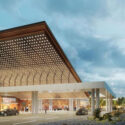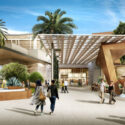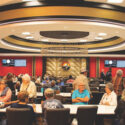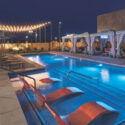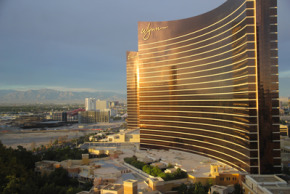
Each year, Casino Design magazine gathers a group of experts in the field to talk about issues that impact their discipline. For this year’s edition, moderator Julie Brinkerhoff Jacobs, the president and chief financial officer of Lifescapes International, Inc., focuses on the crucial subject of non-gaming amenities.
With gaming revenues flat or declining in an increasingly competitive industry, casino resorts are struggling to decide what non-gaming amenities their guests would prefer and what brings the biggest bang for the buck. So sit back and learn how your property can tap into this lucrative market.
The faculty for this year’s roundtable includes:
• Dike Bacon, Principal, Development Leader/Director of Planning and Business Development, Hnedak Bobo
• DeRuyter Butler, Executive Vice President of Architecture, Wynn Design & Development
• Rich Emery, President & Design Principal, Thalden Boyd Emery Architects
• Paul Heretakis, Vice President, Westar Architects
• Tom Hoskens, Vice President, Founding Principal, Cuningham Group
• Bob Kelly, Senior Vice President-Pre-Construction, Roy Anderson Construction
• Andrew Kreft, Executive Senior Principal / Director of Design, Lifescapes International, Inc.
• Patrick Murphy, President, Pechanga Development Corporation
• Stephen Ranck, Southwest Hospitality Practice Area Leader, Gensler
• Richard (Dick) Rizzo, Vice Chairman, Tutor Perini Building Corp.
• Paul Steelman, CEO, Steelman Partners
How can casino operators increase the proportion of non-gaming revenues using the amenities that already exist?
HERETAKIS: Consider other uses for the spaces during hours they may be closed. More focused marketing to specific age groups that don’t currently frequent those amenities can expose them to new customers. Re-invent, re-focus and re-introduce is the key.
HOSKENS: One of the most important ways we help our clients succeed is by creating a mindset of realizing the potential of every space. We design spaces within the resort that can serve and function in a variety of experiences so that lobbies, pools, patios, gazebos, cabanas, pre-function spaces, convention spaces and the like are designed for multiple configurations. Engaging these spaces and making them “rentable” increases non-gaming revenues and diversifies the resort’s amenities to guests and the larger community. In the end, it’s about casinos creating multi-use spaces.
KELLY: The hotel room has always been a place where the gamblers could sleep in between all the excitement of the casino floor and the showroom. No more. In today’s competitive markets, guest rooms are as much of an attraction as the rest of the casino and hotel. We will be exploring current trends that have proven to be successful in increasing guest satisfaction with room accommodations, and especially those that create the desire to come back again for more.
MURPHY: One of the keys to our success has been the constant refreshing and reinventing of our existing facilities. Whether it is hotel rooms, restaurants or meeting facilities, we are regularly renovating the property in order to keep it new and exciting for our guests. In 2014, we unveiled a major multimillion-dollar renovation of our 22,000-square-foot hotel lobby, two restaurants and the addition of two new dining outlets. We saw immediate improvements in the performance of these renovated outlets.
RIZZO: Management needs to be continually aware from customer feedback of upgrades and modifications that would increase revenues. This can be in the number and variety of food and beverage options as well the local and regional competition. Recently, we have seen a trend in adding and upgrading food court offerings and incorporating coffee, dessert and wine tasting to their venues.
STEELMAN: Every casino maximizes the amount of non-gaming revenue for every tandem used space. Simple techniques of advertising (specials, etc.) can increase revenue and attendance. The idea is to develop non-gaming attractions that enhance the casino gaming experience. If that occurs, the activities will be made for one another and the non-gaming and the gaming areas will all be energized with people and profits.
What are some of the factors to consider when adding a hotel to a stand-alone casino?
EMERY: One of the biggest mistakes we see in the addition of hotels adjoining casinos is a lack of connection. Generally speaking, the entry sequence of the casino and hotel should have a “WOW” moment and allow the guests to make choices as to where to go. We always try to have a visual link between the hotel front desk and part of the gaming floor.
HOSKENS: Hotels are not just rooms. Hotels are market differentiators, and it’s critical to use them to that end. Having the ability to vary the room choices within a resort for the clientele desired is the most advantageous.
We work with our clients to understand these four fundamentals:
1: The ratio of rooms to slots. It’s important to size a hotel based on anticipated occupancy and market potential.
2: The need to differentiate your hotel from the competition. A solid market analysis will enable clients to make smart decisions about how they can fill a void in the marketplace and attract guests from the surrounding market or even become a destination magnet.
3: Position the hotel as a core component of the casino resort. An integrated resort works when all the building types complement one another and there is a core purpose and design intent unifying the resort.
4: Create hotel amenities to complement resort amenities.
KELLY: The weakest model we see, and the one to avoid, is the hotel that was not planned. The hotel with no narrative—the hotel that is not marketed to a defined group of guests. Do that and you end up being nothing to anybody rather than something for everyone. As you evaluate options and make decisions, put yourself in your guest’s place. Imagine walking into your room, putting away your clothes, washing up and having a snack. A design and amenities that satisfy you will likely do the same for your guests.
KREFT: We have, from time to time, worked on properties that started out with just a casino. When this occurs, we meet with the team, which usually includes ownership, the architect/planner, general contractor and other operations-oriented team members, to discuss how the overall property will be “master-planned” moving forward. All sorts of conditions need to be addressed early on when considering the addition of a hotel. The significance of a well-functioning porte-cochere (for guests, valet, bus drop, etc.) is as significant as the entry drive approach, access to the pool area within the hotel, its convenience to your hotel guests and the amenities at the pool area that make most sense for a particular property and its guest profile.
We know that your guests’ first impression will be made as they arrive off the main thoroughfare into the casino property. The entry drive would likely need to be upgraded to demonstrate a fresh, new property image. We are only one of several consultants that need to be included at a kick-off meeting to ensure that the site plan is maximizing the best aspects of a property and its marketing intent.
MURPHY: From a tribal gaming perspective, there are a host of factors to consider: market and financial feasibility, how a hotel would fit in the tribe’s long-term business strategy, and regulatory considerations. There are a lot of costs associated with hotel operations, so a threshold question to ask is whether or not a hotel will result in enough increased guest visitations and spend to warrant the expense.
Recently, we announced plans for a non-gaming expansion at Pechanga. The project is designed to meet customer demand for more rooms, a true resort-style pool experience, a luxury spa and more A-list concerts. For us, our decision was rooted in the fact that our existing hotel has been at capacity for several years. Like everyone else, we were affected by the Great Recession, but in recent years, our occupancy rates have rebounded strongly. Just a few months ago, in fact, our team celebrated 365 consecutive days of 100 percent occupancy.
STEELMAN: The adding of a hotel is absolutely a must. There is not one hotel expansion that has not increased the gaming win. The casino’s best customers stay in that hotel.
What does a hotel do for a casino, both in terms of visitations and revenue?
BACON: A hotel speaks to the notion of a resort experience more than any other amenity (golf not withstanding) and is often the primary component of a true integrated resort, which is fancy term for mixed-use development. No other amenity contributes to longer length of stay than a hotel. F&B patronage is significantly stronger with an overnight guest. The fundamental key for success, however, is recognizing that you’re not in the hotel business but the gaming resort business.
EMERY: Properly sized, a hotel should add an incremental drop of 20 percent to 40 percent on the gaming floor. Our historical data from properties shows that an empty guest room on a gaming property loses $50 a room night. The goal of a hotel is to provide a stay-and-play option for that “getaway” guest. Guests will enjoy the amenities more, food and beverage sales will increase and the gaming floor will become more dynamic.
RANCK: With the right mix and critical mass of amenities, hotels within an integrated resort provide the best opportunities for brand loyalty by setting the level of service and providing a unique guest experience. Hotels can connect to guests with authentic local experiences and engage guests with technology to personalize the visit.
Meetings and conventions are a fast-growing part of most resorts. What are the secrets of adding a successful meetings and convention business?
BACON: The meetings and convention business have become extremely competitive, but can be a great non-gaming revenue generator. The average meeting attendee will book an early week room night and use an expense account to spend generously on F&B. One of the biggest contributors to incremental revenue success is the proper promotion of the space to the right groups. It’s no secret that the typical meeting attendee is an average gamer, so it’s critical to market to the right meeting planners in order to land the right demographics.
KELLY: Do the analysis! Meeting space is costly to develop and needs a great business plan to make it successful. Know your market and it will increase hotel visits and increase F&B business; make it too big and you cannot get a return on investment. A great sales staff can fill your meeting space many months in advance; this will mean your hotel rooms on Monday through Thursday will be occupied and create increased room revenue. The analysis will direct you to the right business plan.
KREFT: When we get involved with designing convention centers, we focus on several aspects. We are concerned about accessing parking structures and/or parking lots, providing access for taxi dropoff, guest dropoff and safe walkways from the structures to the convention center (if not integrated directly into the hotel). We also encourage hotel owners and their architects to make sure that there are some areas provided for private, exterior garden areas and patios for special event guests.
RANCK: Technology and ease of access are important for meetings and conventions. Guests are also increasingly looking for sustainable facilities in which to hold their future events. We’ve seen a trend for small to mid-sized hotels to provide flexible meeting centers that can be broken out to service individual clients or combined with larger ballrooms for bigger events. Likewise, larger convention centers are looking at new ways to program flexible ballroom spaces or to make full use of smaller breakout meeting rooms.
RIZZO: Recognize the size, needs and type of conference the convention/trade/professional convention business you are targeting is wanting. Also, the same is true for regional and local community groups/functions.
STEELMAN: Timing is the most critical factor. If you desire to be in the convention expo business, the lead times are very long. Banqueting and small meetings can immediately become successful. Conventions energize the casino and the non-gaming attractions during the middle of the week, when casino traffic is lighter.
Nightclubs are very lucrative but difficult to operate and control. What are some of the factors when considering adding this amenity?
BUTLER: Nightclubs, if done properly, can bring in a whole new source of energy and revenue potential. They also bring a myriad of problems that can be solved, but require special considerations. Factors to consider are crowd management, the crush of peak-time partygoers on other amenities, noise and vibration on adjacent spaces and flexibility to enhance and upgrade as competition shifts or tastes change. Patrons are always looking for the best new thing, so they tend to migrate to the next newest club, making competition stiff and constantly changing.
HERETAKIS: In Vegas, go big or go home! The entry fee is well over $50 million. If you spend less, you are a non-existent B venue with no real attraction or draw. You will be closed within weeks, not even months. The mega-clubs do well, but the days of high profit margins have been given away to DJs and live acts. If you’re up for it, a highly visible club will give you credit among a group of millennials whose true spend value in the long run has yet to be determined.
HOSKENS: The club experience has really exploded onto the scene in a good way, but when you don’t take the time to create a comprehensive plan from design to management, it can go wrong really fast. Not only do you need to think about designing a space that is captivating and one where people want to get energized, you must consider how the club integrates with the entire hotel, resort and casino functions. And don’t forget the importance of the club’s management. Hiring experienced managers and promoters who are part of your resort’s management team will enable close coordination of efforts to give your guests a seamless nightclub and resort experience.
KREFT: We have been involved with many interesting nightclubs inside and outside of the casino areas, having designed many of the “beach club” venues that are really nightclubs for hotel guests and visitors such as Tao Beach, Surrender/Encore and Harrah’s enclosed pool area, which converts to a nightclub venue at night. We have also designed pool areas that are adjacent to primarily indoor nightclubs (for example, XS at Wynn) so that a portion of the pool area at night (and in good weather) can open up some additional exterior seating and bar areas, enhancing the guest experience.
STEELMAN: All nightclubs are not lucrative. Fifty have closed in Las Vegas since the beginning of the craze. We always suggest they should be designed in a place with a secondary use such as a pool, since they are infrequently utilized.
What non-gaming amenity gives the most return on investment? And is that always the wisest choice?
BUTLER: Of the higher return-on-investment amenities, the nightclub scene has quickly become one of the highest potentials as a top lucrative option. Margins can be very high, operating costs can be relatively low (depending on the entertainment policy), and operating time commitment can be as low as two nights per week at four to six hours, or if successful, can be multiple nights. Spillover to other amenities in the facility can boost those operations as well and create an energy buzz.
EMERY: Oddly enough, our experience has shown us that the addition of close covered parking is the best return on investment. It takes the worst weather day—too hot, too cold or raining—and makes it one of the best. Additionally, it moves more guests closer to their first gaming opportunity. Accounting for the expanded parking capabilities, the extended playing time and the inclement weather; the ROI of a parking structure is above 49 percent.
What variables should be considered when a shopping experience is contemplated?
EMERY: There are many variables to consider: the correct mix of stores, the proximity and the demographic. A well-placed series of stores and unique offerings can bring the occasional gamer to your facility. Providing food and beverage offerings that shoppers want, that complement the casino offerings and do not compete, is critical. Proper infrastructure is critical to ease the movement between the resort and shopping.
HERETAKIS: Retail is a very tough offering. Once again, size matters. People want a full mall experience with lots of offerings at all price points. Most of the smaller mini-mall offerings in casinos historically have not done well. People expect their everyday typical stores (Victoria’s Secret, Bebe, H&M) as well as the special treat spend of a luxury brand. Las Vegas retail has also done well because of international tourism. Does your casino have that draw?
HOSKENS: It is not about shopping, it is about creating experiences that excite the guest and allow shopping to happen. It is about placemaking, creating nodes and paths to destinations. It’s not enough to rely on a series of shops to generate a buzz or build your resort’s brand. Our goal for our clients is to design a retail experience that is centered on placemaking. Retail is not just about shopping, it’s about designing a place for people to gather.
How do bars and restaurants complement the casino experience?
BUTLER: Bars and restaurants serve as an amenity to complement gaming by providing a bit of a respite, a pause from the gaming excitement for social interaction with friends to refresh and socialize. They can provide a variety of environments, commensurate with the casino or contrasting, differing cuisine to suit different tastes, maintain the energy level or a time out, and can become a destination in and of themselves with gaming becoming the amenity.
RIZZO: Experience has shown the food and beverage offerings can be both a source of revenue and a way to retain customers in the casino for longer periods of time. Obviously, this greatly depends on the quality and variety of offers, as well as how entertainment offerings are incorporated in them.





